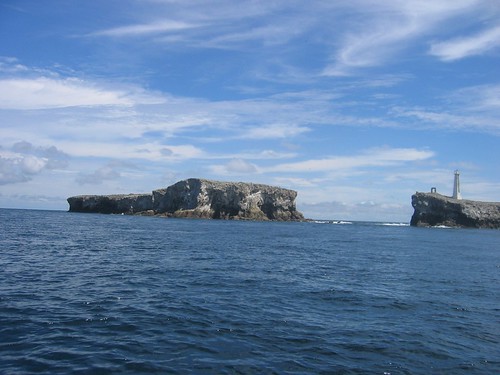PAS Fieldtrip to Islas Frailes.

On Saturday, May 20, a select crew of hardy Panama Audubonites (Bill & Claudia Ahrens, Solange Anchor, and Darién and Delicia Montañez) braved the calm seas and crisp, beautiful rainy-season weather for an afternoon of seabirding around Islas Frailes. A harbringer of the exciting things to come, casual pre-lunch scanning from Venao Beach produced about five Bridled Terns and ten Brown Noddies mixed in with a small flock of Black Terns. Later, when walking down to the boat that we would call home for the following four hours, we found three Elegant Terns with the Laughing Gulls, two flying and one standing on the beach.
Things got more interesting once we were about 2 km offshore, with the appearance of a largeish, all-dark Storm-Petrel that we're calling a Black Storm-Petrel, as well as numerous Bridled and Sooty Terns and Brown Noddies, some carrying fish. Frailes del Sur were covered in birds, most likely nesting. The population of the bigger, southern island was very roughly estimated at around 1500 birds, about half noddies and half Bridled and Sooty Terns. About 10 Brown Boobies and 5 Blue-footed Boobies were also present, as well as a couple Magnificent Frigatebirds and Gray-breasted Martins. A few of the Sooties flying around had noticeable black mottling around the chest, probably young birds, although we saw no birds in full juvenile plumage. Also, a pair of Bridled Terns was seen copulating. The northern, smaller island with the lighthouse had around 500 noddies with 200 Sooty Terns.
After a half hour by Frailes del Sur, we kept on to the south-east until we were about 10 km offshore, then turned west and finally headed back for the Frailes. In those sun-scathed two hours we had close views of a foraging Wedge-rumped Storm-Petrel and crappy looks at a group of three all-dark Storm-Petrels that remained unidentified. Two distant, black-and-white Puffinus shearwaters seen from a distance were probably Galápagos (née Audubon's) Shearwaters; later on we had one fly close enough to the boat to allow identification. After checking the Frailes del Sur we headed for the Frailes del Norte and ran into a second Wedge-rumped Storm-Petrel about halfways there. Frailes del Norte (a.k.a. Islas Monjas) had about 1000 Brown Noddies with about 50 each of Bridled and Sooty Terns, and 25 Blue-footed Boobies.
The morning of Sunday, May 20 was spent at Playa El Agallito in Chitré. The mudflats were full of the usual assortment of shorebirds, including some Black-bellied and Semipalmated Plovers in full breeding plumage, Marbled Godwits, three Red Knots (not in breeding plumage) and a Sanderling (also in nonbreeding plumage). A flock of 40 Common Terns had 10 Least Terns mixed in, as well as a nearby Royal Tern for convenient size comparisons. But the bird of the day was a Ferruginous Pygmy-Owl seen chased by Gray-breasted Martins into a roost hole in a dead palm tree in the the playground, and from there to an acacia tree on the other side of the road, where a female Veraguan Mango fearlessly tried to coax it to leave.